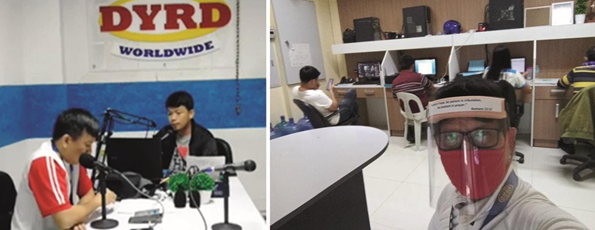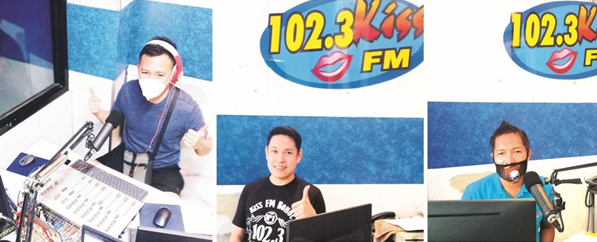By: Sonieta D. Labasan


“Today, I would like us to pray for all those who work in the media, who work to communicate so that people don’t find themselves so isolated, for the education of children, for information to help endure this time of isolation.”
These were the words of Pope Francis before starting his daily mass on Wednesday, April 1, at the Vatican. Such supplication coming from the supreme pontiff of the universal church himself is an explicit recognition of the vital role media plays, specifically in times of a pandemic, as source of reliable and accurate information, channel for education while conveying a sense of normalcy in uncertain times.
Media brings news and updates from reliable sources.
As early as 6 a.m., Boholanos start to tune in to their AM radio for the local morning news or turn on the television for international updates while it has become a habit for many to scroll their newsfeeds for the latest information even before getting out of bed.
At no other time in our recent history has the need for news been so critical in our daily lives and never have we seen real-time facts available at our fingertips. Information is key to keep ourselves and our families safe, giving us understanding of what is happening globally and how it would impact us locally. However, the amount of available information does not only overwhelm us; it also presents a challenge for everyone to sift through a lot of false news, hoaxes, invalidated claims and even conspiracy theories, that vulnerable and non-discriminating readers and audiences may easily fall prey to, causing unnecessary fear and panic.
This is where the value of traditional media cannot be underestimated. First, print and broadcast journalists are accountable to their media outlets. Unlike social media influencers who are mostly working on their own, traditional media practitioners owe it to their companies to contribute towards keeping a reputation of integrity and reliability. Secondly, legitimate journalists are in touch with direct sources. When local chief executives, such as mayors or the governor, need to convey crucial messages to the people, they call on those journalists for an actual press conference.
Finding trusted sources of information regarding COVID-19 is extremely important today; hence, knowing which are trustworthy and untrustworthy sources remains to be the best rule of thumb.
Media keeps factual records for the future.
Last week, we posted photos of old Bohol Chronicle pages that documented epidemics afflicting Boholanos in the 1950s, the ‘60s and even, ‘80s. The article aims to educate young readers with factual events in the past and how our parents and grandparents weathered through such difficult times. There was no intention to sow fear; but rather to insist on faith that we will overcome, as our parents and grandparents before us had survived.
Mass media, especially newspapers, record all kinds of happenings that may be a source of guidance and education for future generations. The documentation is vital because it could present solutions to problems as well as offer hope besides being a fact-checking tool against disinformation or false information.
We are reading today articles containing photos and clippings from old newspapers showing how wearing of masks was mandatory in many US cities after laws were passed to that effect in order to contain the spread of the 1918 Spanish Flu. (Yes, it’s 1918, not 1920. A viral video circulated heavily in social media insinuated that there is a pattern of pandemics happening in 1720, 1820, and 1920, entitled: “1720 Bubonic Plague, 1820 Cholera Outbreak and 1920 Plague.” If you are one of those who shared that video, a little googling should tell you that the dates are not factual and you are only helping spread disinformation.)
Media conveys a sense of normalcy in our lives.
An often unnoticed role of media is how it gives some kind of normalcy even with the quarantine restrictions we are having these days. For instance, those who grow up in Tagbilaran City cannot mistake the voice of DYRD veteran newscaster Fred Araneta who’s been doing the newscast for almost five decades now. We know it’s 7 o’clock in the morning when we hear his familiar voice over the AM station. It signals we have to get to school or to the office in an hour or less.
With many offices, businesses and schools closed, things may still seem good with the world when you tune in to KISS 102.3 and hear your best friend on air, Sean by the Way, or get those needed light moments laughing with Inday Rufing during her noontime program. What all these indicate is that it’s another typical day in the city.
It would be different when you cannot access the radio. We remember in 2013 when the earthquake struck Bohol and for a time, the local air lanes went dead. Many people scrambled in fear and got consoled only upon getting a grip of what’s happening by listening to the radio.
Fast forward to today, the use of both traditional and new media, which includes social media, has not only become habitual but the new normal. For many parents, media becomes the means to keep children at home and be entertained while in isolation.
Undoubtedly, media play an increasing role in our daily lives. No wonder the Pope himself offered a prayer for media professionals. With people perishing and governments strategizing to defeat an unseen enemy, the COVID 19 pandemic is likened to a war which end we have yet to see. All along, media professionals are also risking their lives to bring the latest news by trying to get accurate and timely information from legitimate sources and authorities as well as working to keep everyone informed, entertained and tucked away at home.
